Topic
9 min read



Scanning Probe Electrochemistry: A glossary of terms
Latest updated: August 9, 2023What do the different terms relating to local electrochemistry mean? The following table includes a detailed list of all terms relevant to the fields of scanning probe electrochemistry as well as scanning electrochemical workstations & their associated techniques.
Local Electrochemistry: the definitive guide to terms used in the field
| Term | Technique | Definition | Image | Existing LC Article? |
| alternating current – Scanning Electrochemical Microscopy (ac-SECM) | SECM | A local electrochemical technique which uses an UltraMicroElectrode (UME) in close proximity to a sample surface to measure, and typically map, its local impedance. | 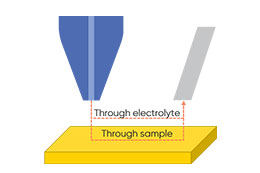 | |
| Amperometric probe | SECM | An amperometric probe is one which measures current. Most SECM experiments are performed using amperometric probes. | ||
| Approach curve | SECM | An approach curve is a main SECM experiment type, often used for positioning the probe in z. In an approach curve the biased probe is moved towards the surface while the probe current (dc-SECM), or impedance (ac-SECM) is measured. Data is plotted as probe position vs. probe signal. | 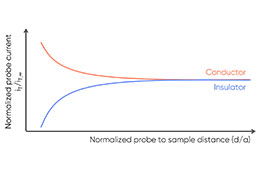 | |
| Backing Potential Controller (BPC) | SKP | The backing potential is the potential applied between the SKP probe and sample in order to null the surface charge between the two. This is sometimes referred to as the Kelvin potential | ||
| Backing Potential Controller (BPC) | SKP | The backing potential controller is the microprocessor used in SKP to measure the output of the Lock-In Amplifier and ensure this output is maintained at zero, by applying a potential to the sample. | ||
| Bi-electrode probe | LEIS | A bi-electrode probe is one which is composed of two electrodes a set distance apart. Bi-electrode probes are used to perform LEIS measurements. | ||
| Capacitive Height Measurement (CHM) | SKP | The Capacitive Height Measurement is one of two SKP based topography measurements. In CHM the current is measured and calibrated to determine the probe to sample distance. As a result, when the probe is scanned across the sample at a fixed height the measured current can be used to map the probe to sample distance, and therefore the sample topography. | 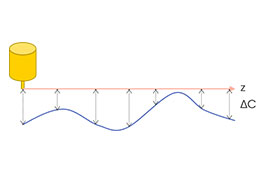 | |
| Capacitive Tracking Measurement (CTM) | SKP | The Capacitive Tracking Measurement is one of two SKP based topography measurements. In CTM the current is measured and calibrated to determine the probe to sample distance. As the probe is scanned across the sample it is moved in z to maintain the initial probe to sample distance throughout the measurement. At each point the probe z position is recorded resulting in a map of the sample topography. | ||
| Closed loop positioning | General | A closed loop positioning system is one in which there is continuous measurement of the position of the movement device by an additional measurement tool and used as a reference against motor repositioning. | ||
| Competition mode | SECM | Competition mode, or redox competition mode, is a mode of SECM in which both the probe and the sample compete to interact with the same redox mediator in solution. The sample may be naturally active towards, or biased to interact with, the redox mediator. | 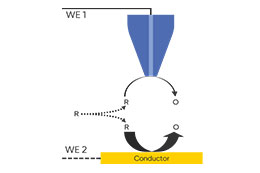 | SECM alphabet soup |
| Constant distance measurement | General | In a constant distance measurement, the probe is positioned a set distance from the sample. Throughout the measurement the probe position changes in order to maintain the probe to sample distance. Using a constant distance measurement removes the effect of sample topography on a given signal. | 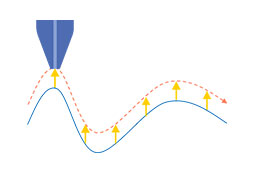 | |
| Constant height measurement | General | In a constant height measurement, the probe is positioned at a set z value, which is maintained throughout the measurement. As the probe is moved across a sample, changes in sample topography cause changes in the probe to sample distance. | 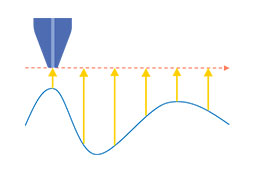 | |
| Diffuse reflection | OSP | In diffuse reflection light is reflected at many angles from a surface. This is used in OSP to measure rough samples, or samples with low reflectivity. | 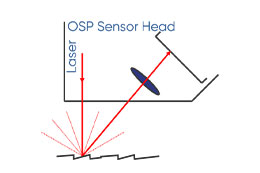 | |
| direct current – Scanning Electrochemical Microscopy (dc-SECM) | SECM | A local electrochemical technique which uses an UltraMicroElectrode (UME) in close proximity to a sample surface to measure its local activity, typically through the measurement of the local current at the biased UME. The presence of a redox mediator is required. | 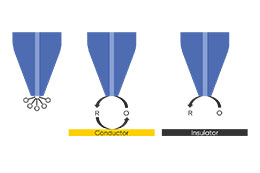 | Introduction to dcSECM |
| Feedback mode | SECM | In feedback mode SECM the probe is biased to interact with a redox mediator added to solution. The sample is not biased, and acts to either regenerate or block the redox mediator of interest. This is the most common mode of SECM. | 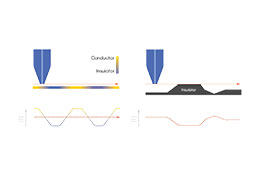 | |
| Flow head | SDS | In Scanning Droplet Cell measurements, a flow head is one in which the electrolyte of interest is flowed through the head, using a pump, to continually refresh the droplet. | ||
| Fringing | SKP | Fringing is the extension of the electric field between two electrodes beyond the edges of the electrodes. This is an effect which must be accounted for in SKP. | 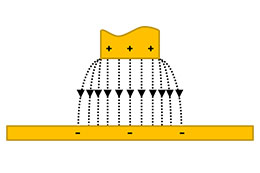 | SKP and the fringing effect |
| Generator / collector mode | SECM | In generator/collector mode SECM the redox mediator of interest is generated during the experiment by the probe or sample. | 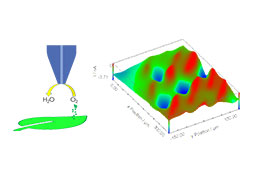 | SECM alphabet soup |
| Height tracking | General | A two-step method of performing a scanning probe measurement with topography relief. In a height tracking measurement, the topography is measured in an initial experiment, which is used as a topography input for a subsequent scanning probe measurement. | ||
| intermittent contact – Scanning Electrochemical Microscopy (ic-SECM) | SECM | A constant distance form of SECM which uses the mechanical vibration of the UltraMicroElectrode (UME) probe in z to control the probe to the surface throughout scanning. | 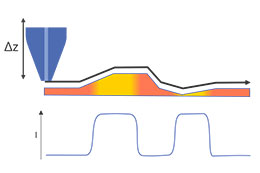 | icSECM101 |
| iR drop | SVET, LEIS | iR drop is the potential difference due to the passage of current, i, through a resistive component, i.e. the electrolyte, with resistance, R. It is also known as ohmic drop. iR drop in electrolyte is used by both LEIS and SVET to measure the local electrochemistry of a sample. | ||
| Local Electrochemical Impedance Mapping (LEIM) | LEIS | Local Electrochemical Impedance Mapping refers specifically to the LEIS measurements performed at a single frequency while the probe is raster scanned across a sample to build up a line or area scan. | 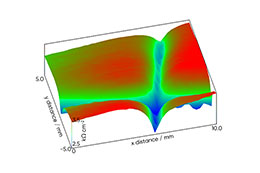 | Introduction to LEIM |
| Localized Electrochemical Impedance Spectroscopy (LEIS) | LEIS | Localized Electrochemical Impedance Spectroscopy is a local electrochemistry technique which uses a bi-electrode in close proximity to a sample surface to measure its local impedance. | 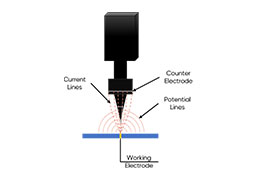 | Introduction to LEIS |
| Negative feedback | SECM | In feedback mode SECM when the probe is approached to an insulator the current decreases with decreasing probe to sample distance. This is negative feedback. | 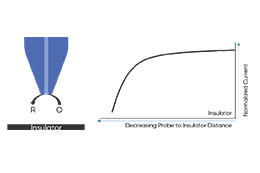 | |
| Null point | SKP | The null point in SKP is the value at which the applied backing potential results in no electron flow between the probe and the sample, and therefore no voltage is measured. | ||
| Optical Surface Profiler (OSP) | OSP | The Optical Surface Profiler experiment uses a laser displacement sensor to map the local topography of a sample. | 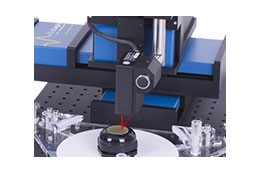 | Introduction to OSP |
| Over sampling | General | Oversampling is a method used in scanning probe measurements in which the step size is smaller than the probe diameter, which typically controls the measurement resolution. This allows further resolution of sample features. | ||
| Overscan | General | Overscan is used when measurements are performed in sweep scan mode. It is a scanning period of known distance during which the axis reaches the required scan rate, and no data is collected. | ||
| Point In Space (PIS) | SVET, LEIS | A point in space is a sample type in which a conductor is surrounded by an insulator allowing current to be driven from a single defined location. It is also known as a point source. The point in space is used in SVET and LEIS. | ||
| Positive feedback | SECM | In feedback mode SECM when the probe is approached to a conductor the current increases with decreasing probe to sample distance. This is positive feedback. | 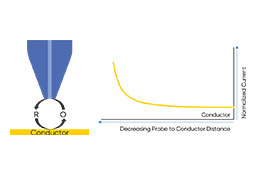 | |
| Potentiometric probe | SECM | A potentiometric probe is one which is used to measure potential. Potentiometric probes are used, for example, in SECM to measure local pH. | ||
| Probe to sample distance | General | The probe to sample distance is the distance in z, between the probe and the sample. In scanning probe measurements, the probe to sample distance affects the signal measured. | 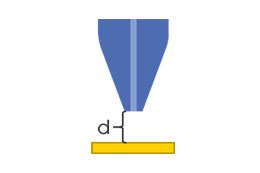 | |
| Raster scan | General | In scanning probe electrochemistry raster scanning refers to the top to bottom, line by line measurement pattern used by the probe to build up line and area scans. | ||
| Redox mediator | SECM | A redox mediator is an electrochemically active molecule which is key to a dc-SECM experiment. | Introduction to the redox mediator | |
| Reservoir head | SDS | In the Scanning Droplet Cell technique, a reservoir head is one in which a reservoir above the capillary opening holds all of the electrolyte available to the droplet during the experiment. Electrolyte in the droplet is only refreshed in an experiment as it is used up through capillary action. | ||
| RG ratio | SECM | The RG ratio is the ratio of the insulating sheath of the electrode to the active area of the electrode. The RG ratio affects the sensitivity of the measurement. | 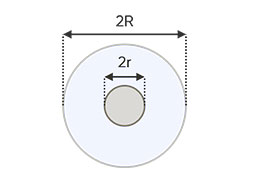 | |
| Scanning Droplet Cell (SDC) | SDS | Scanning Droplet Cell is a scanning technique which uses a droplet formed between a sample and capillary head to measure the local electrochemistry of a working electrode sample. It is also referred to as Scanning Droplet System (SDS). | 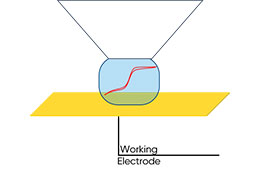 | Introduction to scanning droplet cell |
| Scanning Electrochemical Microscopy (SECM) | SECM | Scanning electrochemical microscopy is a scanning probe electrochemistry technique which uses an ultramicroelectrode in close proximity to measure the local activity of a sample in solution. This is typically achieved by measuring the local current (dc-SECM), or impedance (ac-SECM). | 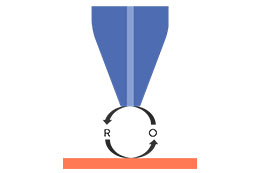 | Introduction to SECM |
| Scanning electrochemical workstation | General | A scanning electrochemical workstation is any of a range of instruments which has the ability to contain multiple scanning probe electrochemistry techniques. | 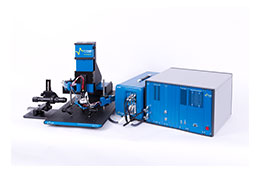 | Factors to consider when buying a scanning electrochemical workstation |
| Scanning Kelvin Probe (SKP) | SKP | SKP is a scanning probe measurement based on a parallel plate capacitor formed between the probe and sample. Using SKP the local contact potential difference, which can be related to the sample work function or corrosion potential, can be mapped. | 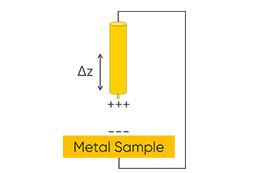 | Introduction to SKP |
| Scanning probe electrochemistry | General | Scanning probe electrochemistry is a family of techniques which use a probe raster scanned in close proximity to the sample surface to map its local electrochemistry. | 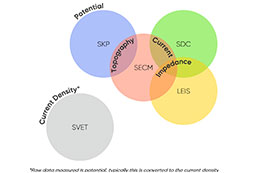 | |
| Scanning Reference Electrode Technique (SRET) | SVET | The Scanning Reference Electrode Technique is a precursor to SVET. SRET was used to locally measure micro-galvanic potentials, which can be calibrated to map the current density of a sample. | Introduction to scanning reference electrode technique | |
| Scanning Vibrating Electrode Technique (SVET) | SVET | The Scanning Vibrating Electrode Technique is a local electrochemistry technique which uses a vibrating probe in close proximity to a sample to measure local potential. The data can be calibrated to map the current density of a sample. SVET is also known as Scanning Vibrating Probe (SVP), and Vibrating Probe. | 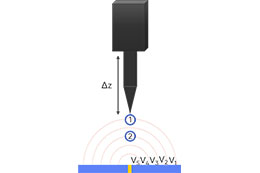 | Introduction to SVET |
| Shadowing | OSP | Shadowing occurs in OSP when a sample topographic feature blocks the reflection of the laser from reaching the sensor. | 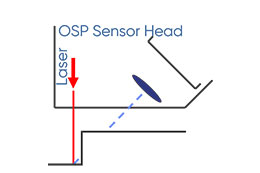 | |
| Specular reflection | OSP | In specular reflection light is reflected at a defined angle. In OSP specular reflection is used to measure smooth, or mirror like samples. | 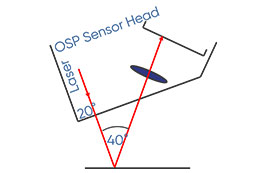 | |
| Step scan | General | Step scan is one of two scan modes used in scanning probe experiments. In a step scan experiment the probe pauses at each point in the scan to measure the local signal. Once the point measurement is complete the probe moves to the next point to pause and measure the local signal, this is repeated to build up the full experiment. | 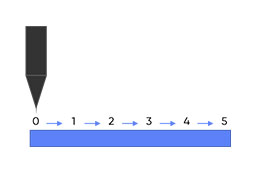 | |
| Substrate Generation / Tip Collection mode (SG/TC) | SECM | Substrate generation / tip collection mode is an SECM mode in which the tip is biased to interact with (collect) the redox mediator generated by the sample. | 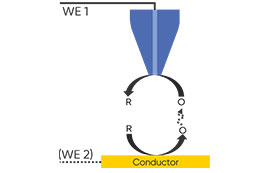 | SECM alphabet soup |
| Sweep scan | General | Sweep scan is one of two scan modes used in scanning probe experiments. In a sweep scan experiment the probe scans an entire line, without stopping. The signal is measured at a given time interval, which because the scan velocity is known, is converted to a distance interval. | 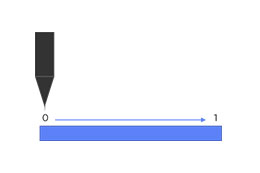 | |
| Tip Generation / Substrate Collection mode | SECM | Tip generation / substrate collection mode is an SECM mode in which the tip generates the redox mediator which the substrate is biased to collect. | 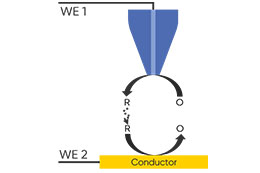 | SECM alphabet soup |
| UltraMicroElectrode (UME) | SECM | Ultramicroelectrodes are electrodes with an active diameter on the micrometre scale or smaller. UMEs are used as the measurement probe in SECM, for which they typically have a diameter of 25 µm or smaller. | ||
| Volta potential / Contact potential difference | SKP | The Volta potential, or contact potential difference is the potential difference between the SKP probe and sample in electrical contact. It is directly related to the corrosion potential, Ecorr, and work function of a sample. |